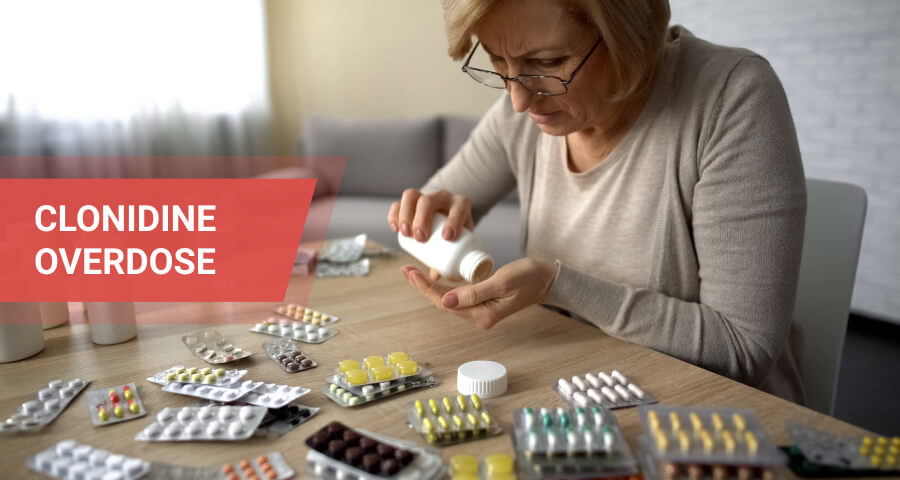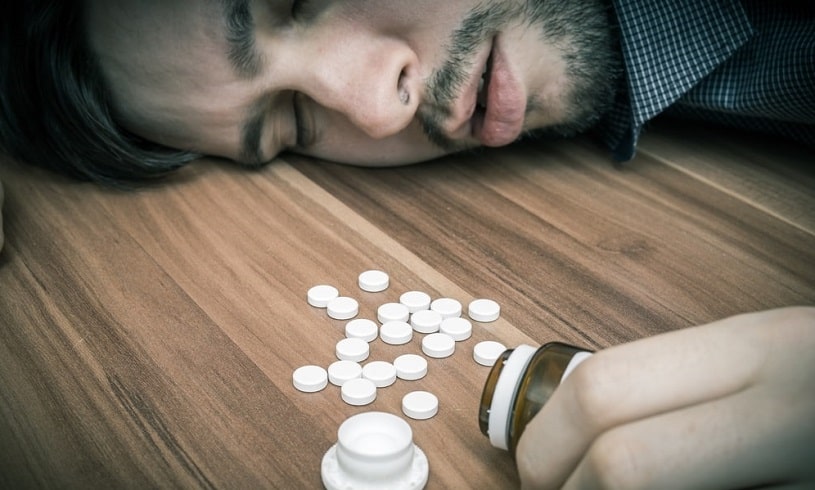
Clonidine is an effective medication used to treat high blood pressure, ADHD, and even withdrawal from substances. When taken as prescribed, it is relatively safe. However, clonidine overdose is also possible. Both adults and children can fall victim to clonidine toxicity. Users should have all information about overdose prevention and treatment if they take or plan to take Catapres.
So, how much Clonidine to overdose? How to recognize the signs? And is there a clonidine antidote?
Table Of Contents:
How Clonidine Overdose Can Occur
Patients taking Catapres, especially those misusing it, wonder if a clonidine overdose is possible. The simple answer is yes.
While it is considered a safe medication, its ingredients are potent, so it is formulated in small doses compared to most other medicines. Clonidine adverse effects occur easily, especially if too much is taken.
Overdoses have occurred in both adults and children. In adults, they are more common simply because they are more likely to be prescribed and access the medication. OD in adults did occur at times when the only medicine taken was Catapres. However, it was more likely to happen when the drug was taken with other substances. Catapres overdose does not occur in the same way each time it happens.
There Are Several Ways Someone Might Take an Excessive Dose of the Medication:
- Intentionally taking too much: This can occur because the user is attempting to try to use the drug recreationally or as a result of suicidal thoughts.
- Unintentionally taking too much: Sometimes, users might forget they have already taken a dose and end up taking two or more doses at once. If they have trouble metabolizing the drug, it may also build up in their system.
- Mixing Catapres with other substances accidentally: The medicine interacts negatively with many other medications and substances. Someone might accidentally combine it with something potentially dangerous.
- Mixing it with other substances on purpose: Catapres is known to heighten the effects of certain substances, especially opioid medications. Drug abusers might combine them on purpose to get a stronger effect.
- Taking Catapres in the wrong way: Snorting crushed pills or injecting liquified powder makes it easier to take an excessive dose of the medicine, not to mention other complications.
- Taking Catapres purchased on the street: Medications not purchased through a reputable pharmacy may not be what they claim. They could contain larger amounts of the drug or be mixed with substances that make it more dangerous to use.
Abuse, misuse, and buying medication in the unlicensed pharmacy are strongly discouraged as they put a patient in danger and are illegal.
Clonidine Toxicity In Children
Catapres poisoning in children is much riskier than when it happens in adults. Children are more likely to experience an OD than adults due to the differences in their bodies and the fact that they might take someone else’s medication out of curiosity or put on a discarded patch to be more like mom or dad. It can also be more difficult to get treatment for Catapres overdose, as caregivers may not suspect the child took the medication.
OD in pediatric patients is not due to taking the medication as prescribed. Instead, Catapres overdose in children tends to occur when kids get ahold of the medication bottle and take multiple doses at once. It tends to be more dangerous than in adults as it is more likely to result in a coma.

According to a study on pediatric clonidine exposures reported to poison centers, only in 10% of OD cases in children younger than six years old Clonidine was the child’s medication. It backs up the claim that most overdoses in pediatric patients occur due to kids accidentally getting access to the drug. Although most of the symptoms were minor, 2% of children experienced major effects, and there was even one fatality.
Children will experience OD at a much lower dosage. A single tablet is enough to put young children into a coma. Sadly, Catapres overdose is becoming more and more common among children.
How Much Clonidine To Overdose
There is no set amount of the drug that will result in OD for every patient. Overdoses can occur at any time more than the maximum safe dose is taken, or it is mixed with contraindicated substances. It can also happen when someone is taking certain medications or has a health condition that lowers the toxicity threshold. However, certain situations make Clonidine toxicity more likely to occur.
Trying To Abuse Medication
The situation most likely to result in Catapres poisoning is attempting to make the effect from another substance more potent. This is because it is more likely that the medication will be taken in a large amount or ingested in an unapproved way. Additionally, if another substance is taken, there is the risk of overdosing from it as well.
Enhancing The Medication’s Effects
Another possibility to reach Catapres overdose is that someone might be struggling with the condition that Catapres is prescribed to treat and want to take a larger dose for a more powerful effect. It is more likely with disorders like ADHD and insomnia. For example, the patient might increase the Catapres dose for sleep if they are having trouble drifting off one night.
Other situations that increase the risk are taking Clonidine and alcohol at the same time, starting a new medication without disclosing Catapres use, and taking high doses despite a contraindicated health condition.
Clonidine Overdose Symptoms
The poisoning symptoms can vary between patients and tend to present more severely in children than in adults. As soon as symptoms are observed, treatment must be sought. Calling 911 is best, but if it is not an option, someone other than the person taking an excessive dose should get them to an emergency room.
Clonidine Overdose Symptoms Include:
- High blood pressure
- Reduced heart rate
- Passing out
- Shaking
- Struggles with breathing
- Lethargy
- Difficulty speaking
- Skin that is cold to the touch
- Weakness
- Constricted pupils
- Sinus bradycardia, particularly in children
- Coma
The overdose symptoms are severe and can lead to death. They must be taken seriously by users and those around them. Never dismiss potential signs of OD.
Death From Clonidine Overdose
It is important to note that how much Clonidine to die is different from how much is considered an excessive dose. The LD50 of the medication is 465 mg per kilogram of body mass in rats. It means that a guaranteed deadly dose for most adult humans will require many thousands of milligrams of the substance. OD will occur much earlier than that and still carry the risk of death.

While a clonidine overdose death from the medication alone would be highly unusual, it is still possible. Users should be aware that the more drugs and substances they take with the drug, the greater the risk that an excessive dose will turn deadly. The high LD50 should not make anyone feel safe when abusing the medication.
Clonidine Overdose Treatment
Clonidine overdose treatment is different from that for most other medications. Activated charcoal and lavage are not options as the CNS depression and aspiration risk associated with this type of OD are high.
The Following Treatment Works for Catapres Poisoning:
- Ensuring adequate blood flow
- Assisted ventilation
- Controlled ventilation
- Naloxone therapy
Naloxone therapy can be used as a clonidine antidote. However, its use and effectiveness are still uncertain. That is because case reports are showing different outcomes influenced by unknown cofactors.
In one case report, a patient did not respond to Naloxone and was given yohimbine. The overdose symptoms subsided one hour later. It shows that there is no specific clonidine antidote, and the treatment may include the use of different medications. Clonidine half-life is approximately 14 hours, meaning it can take some time before a person recovers. With an excessive amount, it can take even longer.

Treating an overdose in children is different from that in adults. Targeted medications are required to manage specific symptoms of an excessive dose. For example, atropine for bradycardia and dopamine for hypotension. Careful monitoring of the vital signs is critical for proper management.
Ending Clonidine Misuse
Clonidine toxicity can occur due to different reasons. However, the most likely cause for a clonidine overdose is the abuse of the drug. If someone is misusing the medication, they should seek help from an addiction treatment center. There, the trained staff can design the best working treatment for substance abuse for each patient. It’s not worth going through all the withdrawal symptoms alone. Medical professionals around can ensure that the process is as safe and comfortable as it can be.
Keep your medication away from children to prevent them from accidentally overdosing. With all precautions taken, patients can avoid overdoses. Search for medical advice if there are any concerns about drug interactions or the dose.
Hope Without Commitment
Find the best treatment options. Call our free and confidential helpline
Most private insurances accepted
Find Drug Rehabilitation Centers Near You Anywhere In the US
Addiction Resource team has compiled an extensive list of the top drug rehabilitation facilities around the country. Use our locator tool to find the best centers near you.
Page Sources
- Isbister, G. K., Heppell, S. P., Page, C. B., & Ryan, N. M. (2017). Adult clonidine overdose: prolonged bradycardia and central nervous system depression, but not severe toxicity. Clinical Toxicology, 55(3), 187-192. https://www.ncbi.nlm.nih.gov/pubmed/28107093.
- Spiller, H. A., Klein-Schwartz, W., Colvin, J. M., Villalobos, D., Johnson, P. B., & Anderson, D. L. (2005). Toxic clonidine ingestion in children. The Journal of pediatrics, 146(2), 263-266. https://www.ncbi.nlm.nih.gov/pubmed/15689921.
- Klein-Schwartz, W. (2002). Trends and toxic effects from pediatric clonidine exposures. Archives of pediatrics & adolescent medicine, 156(4), 392-396. https://pubmed.ncbi.nlm.nih.gov/11929375/
- WEDIN, G. P., RICHARDSON, S. L., & WALLACE, G. H. (1990). Clonidine poisoning in children. American Journal of Diseases of Children, 144(8), 853-854. https://jamanetwork.com/journals/jamapediatrics/article-abstract/515258.
- Amico, K., Cabrera, R., & Ganti, L. (2019). Outcomes following clonidine ingestions in children: an analysis of poison control center data. International journal of emergency medicine, 12(1), 1-6. https://pubmed.ncbi.nlm.nih.gov/31272388/
- Roberge, R. J., McGuire, S. P., & Krenzelok, E. P. (1996). Yohimbine as an antidote for clonidine overdose. The American journal of emergency medicine, 14(7), 678-680. https://www.sciencedirect.com/sdfe/pdf/download/eid/1-s2.0-S0735675796900881/first-page-pdf
- Manzon L, Nappe TM, Maguire NJ. Clonidine Toxicity. In: StatPearls. Treasure Island (FL): StatPearls Publishing; 2020. https://www.ncbi.nlm.nih.gov/books/NBK459374/.
- Catapres® (clonidine hydrochloride, USP). Boehringer Ingelheim International. 2009. https://www.accessdata.fda.gov/drugsatfda_docs/label/2009/017407s034lbl.pdf.
- Olsson, J. M., & Pruitt, A. W. (1983). Management of clonidine ingestion in children. The Journal of pediatrics, 103(4), 646-650. https://www.ncbi.nlm.nih.gov/pubmed/6137526.


 Reviewed by:
Reviewed by:  Written by:
Written by: 

 FindTreatment.gov
FindTreatment.gov